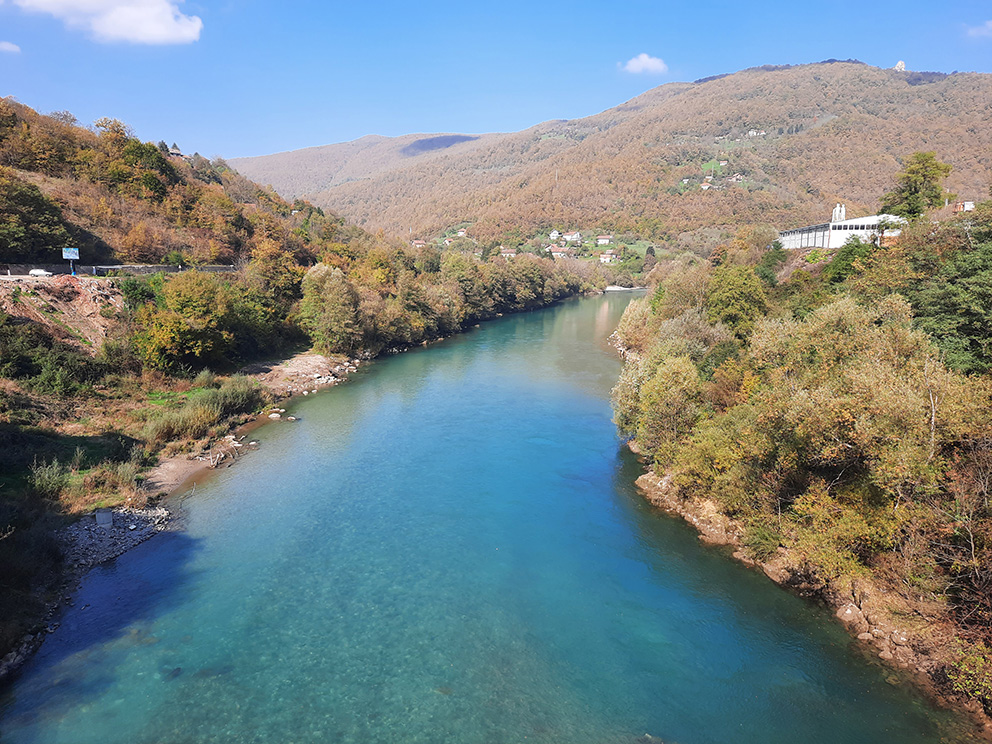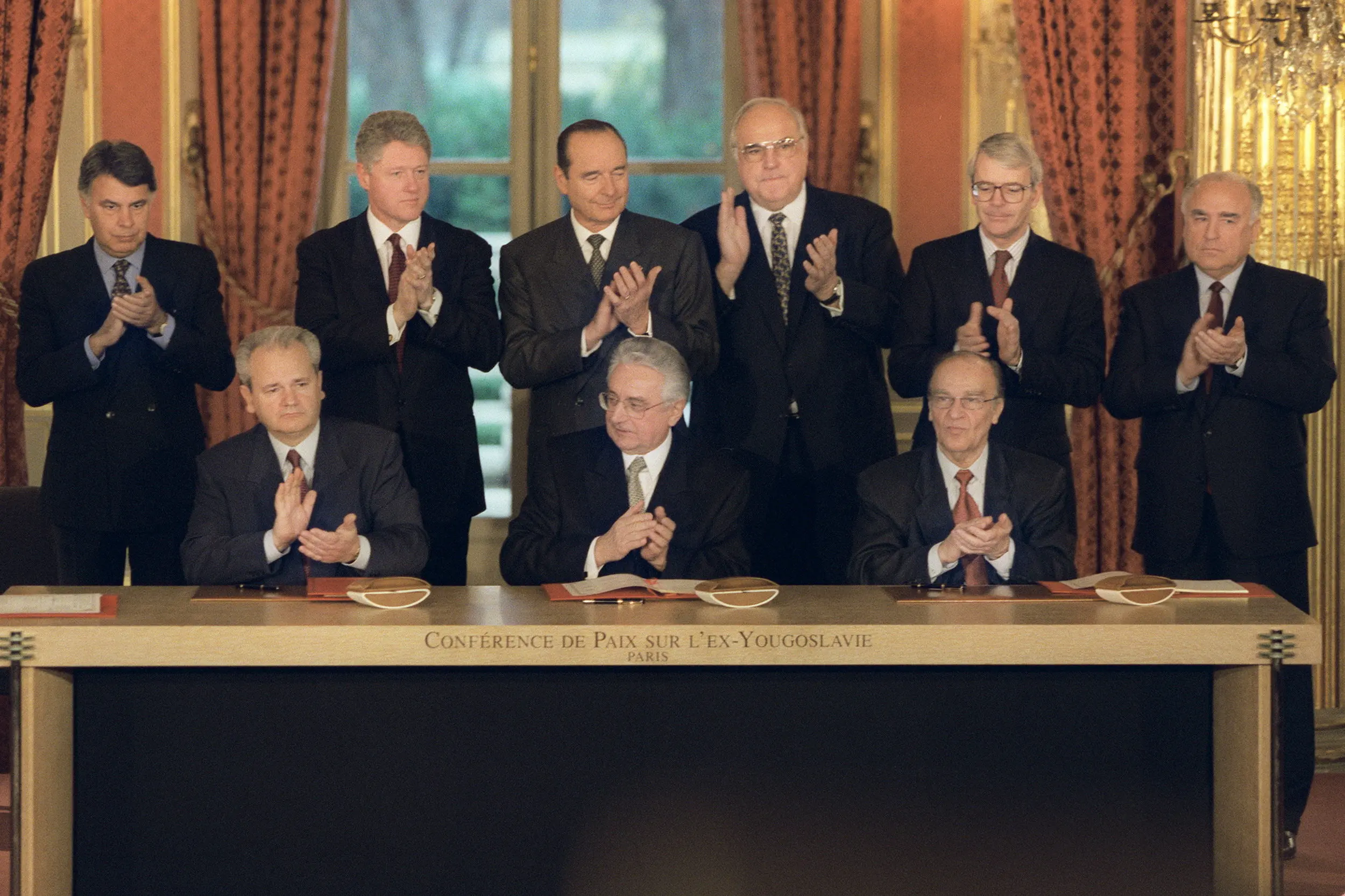Bosnia and Herzegovina, following the Drina
Our reportage along the Drina continues, following one of the most important and celebrated rivers in Bosnia and Herzegovina. In this episode we discover canyons and rafting, the Sutjeska National Park with the famous monument by Miodrag Živković and the city of Goražde

Bosnia-Erzegovina-lungo-la-Drina
The Drina River, near Brod, view from the bridge connecting the M18 and M20 roads (photo G. Vale)
The M18 (E762) state road follows the upper course of the Drina to the border between Bosnia and Herzegovina and Montenegro. The asphalt is so bleached by the sun that the roadway occasionally merges with the gravel of the improvised rest areas at the side of the road. On this winter day, cars are rare and you only need to slow down a little to hear the sound of the river gurgling a few meters below.
After the last bend, the navigator indicates that in front of us, somewhere in the bushes, is the exact point where the Tara and Piva rivers meet, giving birth to the Drina. From the road, however, the view is terrible and, after several attempts to park in order to take a photo, I am forced to give up so as not to attract the attention of the border policemen who, evidently bored, look at me curiously from the border crossing 300 meters away.
Life along the Drina River
Luckily, this area is a paradise for rafting centers, and on both sides of the border, dozens of steep, uneven paths lead down from the M18 to the riverbed. In Bosnia and Herzegovina, the rafting center closest to the confluence of the Tara and Piva is “Divlja Rijeka” [Wild River], opened by Milan Rudinac in 2013. Arriving at his campsite, I realise that the rafting season has long been over. It is time for rest, maintenance work and partying with friends.
“I have been running this business for almost 25 years,” Milan tells me. “At first, I stayed with my tourists in tents in the Drina canyon, then I started relying on other campsites and eventually I built my own center. Currently, I receive about 2,000 people every summer”. Travelers come from all over the world and for many this is, literally, the first dive to the heart of the Balkans.
“I took my first steps along the Drina. This is where I learned to swim, fish, dive and kayak… It is hard for me to imagine a life away from the river. Maybe that is why I have never left this region,” continues Milan Rudinac, and admits: “When I move away from the Drina, I can still smell it and hear the sound of its rapids”.
Development all-around
As we speak, the water flows steadily a few meters away, already in the shadow of the canyon where the sun is setting. “Divlja Rijeka” is the first campsite and rafting center that you come across along the Drina, but certainly not the last. “Lately, more and more people who have nothing to do with nature have been coming here”, laments Milan, who hopes that “their awareness of the river and nature in general will change a little”.
As river tourism becomes more and more popular, the area is attracting more investors. Not far from Milan’s campsite, a much larger centre is being built, and along the road to Foča there is a continuous succession of small paths leading down to the riverbed, with signs announcing the presence of a “camping” or a “rafting centre”. But it is not just sports. There are those who would like to build hydroelectric power plants along the upper reaches of the Drina.
“There are many political interests and we can hardly do anything against these projects, but we will not stop fighting to prevent these power plants from being built”, assures Milan Rudinac.
Four small hydroelectric power plants are planned to be built between Foča and the Bosnian-Montenegrin border: Foča, Sutjeska, Buk Bijela and Paunci. However, the project, supported by Republika Srpska and Serbia, seems to be on hold.
In early 2024, twenty-four Bosnian MPs appealed to the Constitutional Court in Sarajevo questioning the right of Republika Srpska to conclude international agreements. In short, the issue remains unresolved for now.
From the valley to the city of heroes
Continuing along the M18 state road, after a long series of campsites, at the exact point where the Zip line and an airsoft shooting range are located, the Drina meets its first tributary: the Sutjeska, which is not just any river.
The eponymous national park, the oldest in Bosnia and Herzegovina, was created along the Sutjeska River in 1962 and is internationally known for the impressive monument built in 1971 in Tjentište by Serbian sculptor Miodrag Živković.
Here, in the so-called “Valley of Heroes”, a memorial centre commemorates the Battle of Sutjeska fought in the summer of 1943 between Tito’s partisans and the Axis powers.
As we arrive at the foot of the hill that leads to the monument – two 19-meter-high concrete wings from which you can see the entire valley and the mountains in the background – small groups of tourists are completing their visit. The license plates of their cars reveal their provenance: Slovenia, Croatia, Serbia, Bosnia and Herzegovina…
When it is empty, immersed in the silence of nature, this place seems to belong to another, distant era, if not another planet, with an alien sculpture that seems to have magically landed on the hill. But when filled with visitors, the Tjentište memorial park suddenly regains its function, as an element that unites peoples who today live in different countries and, of course, as a reminder of the war of liberation.
More than eighty years ago, the partisans managed to escape the Nazi-fascist encirclement, crossing the Sutjeska canyon and heading northeast towards Goražde. We follow the same route, although not through the forest, along the M20 which near Foča replaces the M18 following the course of the Drina (this time on the left side).
This is also where the stories of war crimes begin, which unfortunately will accompany our river for most of its course. At the beginning of the war in Bosnia and Herzegovina, in 1992, Serbian troops committed the first crimes along the Drina.
The Aladža Mosque in Foča, one of the most important in Bosnia and Herzegovina, was reopened to the public only in 2019. Completed in 1550, it was blown up in 1992 by the Army of Republika Srpska, and for more than two decades the clearing where it stood – on the banks of the Ćehotina River, another tributary of the – remained empty.
About ten kilometers further north, the town of Ustikolina marks the passage from the Republika Srpska to the Federation of Bosnia and Herzegovina (FBiH): a small enclave that ends about twenty kilometers further, in Goražde, the “city of heroes” (between the two cities, near Mravinjac, a huge inscription “Tito” stands on the hill: a tribute to the Yugoslav leader created in 1980 on the occasion of his death).
Goražde, which today seems like a peaceful town with about 20,000 inhabitants nestled on the banks of the Drina, was besieged by Bosnian Serb troops for more than 1,300 days, from 1992 to 1995, experiencing a fate similar to that of Sarajevo, about a hundred kilometers away.
The town managed to resist and, under the Dayton Agreement, was incorporated into the Croat-Muslim federation, connected by a narrow corridor to the rest of the entity. Many readers are probably familiar with it thanks to the award-winning graphic novel that Joe Sacco dedicated to Goražde after his stay in the city in 1995-96.
Today, the city skyline is dominated by the tall minarets of the Kajserija Mosque, built in 2009 with Turkish support. The pedestrian bridge over the Drina is decorated with pots of pink and red geraniums, and the terrace of the “Bosanka” restaurant on Defenders’ Square is bustling with people who come to enjoy the sun and the wind blowing along the river.
A few meters further down, just below the pedestrian bridge and above the Drina, one can still see the “bridge under the bridge” built in 1994 to provide a safe connection between the two banks, sheltered from Serbian artillery.
The structure is accessed from the southern bank, not far from the monument to the children who died during the siege. In the future, the “bridge under the bridge” should be fully restored and included in the local tourist offer. It may not be as famous as the one immortalised by Ivo Andrić in his novel, but the “bridge under the bridge” also bears witness to an important chapter of life along the Drina.
It is time to leave Goražde and head back on the M20 towards Višegrad, the next stop on our journey along the river.
To be continued
This publication has been produced within the Collaborative and Investigative Journalism Initiative (CIJI ), a project co-funded by the European Commission. The contents of this publication are the sole responsibility of Osservatorio Balcani Caucaso Transeuropa and do not reflect the views of the European Union. Go to the project page
Tag: CIJI
Featured articles
- Take part in the survey
Bosnia and Herzegovina, following the Drina
Our reportage along the Drina continues, following one of the most important and celebrated rivers in Bosnia and Herzegovina. In this episode we discover canyons and rafting, the Sutjeska National Park with the famous monument by Miodrag Živković and the city of Goražde

Bosnia-Erzegovina-lungo-la-Drina
The Drina River, near Brod, view from the bridge connecting the M18 and M20 roads (photo G. Vale)
The M18 (E762) state road follows the upper course of the Drina to the border between Bosnia and Herzegovina and Montenegro. The asphalt is so bleached by the sun that the roadway occasionally merges with the gravel of the improvised rest areas at the side of the road. On this winter day, cars are rare and you only need to slow down a little to hear the sound of the river gurgling a few meters below.
After the last bend, the navigator indicates that in front of us, somewhere in the bushes, is the exact point where the Tara and Piva rivers meet, giving birth to the Drina. From the road, however, the view is terrible and, after several attempts to park in order to take a photo, I am forced to give up so as not to attract the attention of the border policemen who, evidently bored, look at me curiously from the border crossing 300 meters away.
Life along the Drina River
Luckily, this area is a paradise for rafting centers, and on both sides of the border, dozens of steep, uneven paths lead down from the M18 to the riverbed. In Bosnia and Herzegovina, the rafting center closest to the confluence of the Tara and Piva is “Divlja Rijeka” [Wild River], opened by Milan Rudinac in 2013. Arriving at his campsite, I realise that the rafting season has long been over. It is time for rest, maintenance work and partying with friends.
“I have been running this business for almost 25 years,” Milan tells me. “At first, I stayed with my tourists in tents in the Drina canyon, then I started relying on other campsites and eventually I built my own center. Currently, I receive about 2,000 people every summer”. Travelers come from all over the world and for many this is, literally, the first dive to the heart of the Balkans.
“I took my first steps along the Drina. This is where I learned to swim, fish, dive and kayak… It is hard for me to imagine a life away from the river. Maybe that is why I have never left this region,” continues Milan Rudinac, and admits: “When I move away from the Drina, I can still smell it and hear the sound of its rapids”.
Development all-around
As we speak, the water flows steadily a few meters away, already in the shadow of the canyon where the sun is setting. “Divlja Rijeka” is the first campsite and rafting center that you come across along the Drina, but certainly not the last. “Lately, more and more people who have nothing to do with nature have been coming here”, laments Milan, who hopes that “their awareness of the river and nature in general will change a little”.
As river tourism becomes more and more popular, the area is attracting more investors. Not far from Milan’s campsite, a much larger centre is being built, and along the road to Foča there is a continuous succession of small paths leading down to the riverbed, with signs announcing the presence of a “camping” or a “rafting centre”. But it is not just sports. There are those who would like to build hydroelectric power plants along the upper reaches of the Drina.
“There are many political interests and we can hardly do anything against these projects, but we will not stop fighting to prevent these power plants from being built”, assures Milan Rudinac.
Four small hydroelectric power plants are planned to be built between Foča and the Bosnian-Montenegrin border: Foča, Sutjeska, Buk Bijela and Paunci. However, the project, supported by Republika Srpska and Serbia, seems to be on hold.
In early 2024, twenty-four Bosnian MPs appealed to the Constitutional Court in Sarajevo questioning the right of Republika Srpska to conclude international agreements. In short, the issue remains unresolved for now.
From the valley to the city of heroes
Continuing along the M18 state road, after a long series of campsites, at the exact point where the Zip line and an airsoft shooting range are located, the Drina meets its first tributary: the Sutjeska, which is not just any river.
The eponymous national park, the oldest in Bosnia and Herzegovina, was created along the Sutjeska River in 1962 and is internationally known for the impressive monument built in 1971 in Tjentište by Serbian sculptor Miodrag Živković.
Here, in the so-called “Valley of Heroes”, a memorial centre commemorates the Battle of Sutjeska fought in the summer of 1943 between Tito’s partisans and the Axis powers.
As we arrive at the foot of the hill that leads to the monument – two 19-meter-high concrete wings from which you can see the entire valley and the mountains in the background – small groups of tourists are completing their visit. The license plates of their cars reveal their provenance: Slovenia, Croatia, Serbia, Bosnia and Herzegovina…
When it is empty, immersed in the silence of nature, this place seems to belong to another, distant era, if not another planet, with an alien sculpture that seems to have magically landed on the hill. But when filled with visitors, the Tjentište memorial park suddenly regains its function, as an element that unites peoples who today live in different countries and, of course, as a reminder of the war of liberation.
More than eighty years ago, the partisans managed to escape the Nazi-fascist encirclement, crossing the Sutjeska canyon and heading northeast towards Goražde. We follow the same route, although not through the forest, along the M20 which near Foča replaces the M18 following the course of the Drina (this time on the left side).
This is also where the stories of war crimes begin, which unfortunately will accompany our river for most of its course. At the beginning of the war in Bosnia and Herzegovina, in 1992, Serbian troops committed the first crimes along the Drina.
The Aladža Mosque in Foča, one of the most important in Bosnia and Herzegovina, was reopened to the public only in 2019. Completed in 1550, it was blown up in 1992 by the Army of Republika Srpska, and for more than two decades the clearing where it stood – on the banks of the Ćehotina River, another tributary of the – remained empty.
About ten kilometers further north, the town of Ustikolina marks the passage from the Republika Srpska to the Federation of Bosnia and Herzegovina (FBiH): a small enclave that ends about twenty kilometers further, in Goražde, the “city of heroes” (between the two cities, near Mravinjac, a huge inscription “Tito” stands on the hill: a tribute to the Yugoslav leader created in 1980 on the occasion of his death).
Goražde, which today seems like a peaceful town with about 20,000 inhabitants nestled on the banks of the Drina, was besieged by Bosnian Serb troops for more than 1,300 days, from 1992 to 1995, experiencing a fate similar to that of Sarajevo, about a hundred kilometers away.
The town managed to resist and, under the Dayton Agreement, was incorporated into the Croat-Muslim federation, connected by a narrow corridor to the rest of the entity. Many readers are probably familiar with it thanks to the award-winning graphic novel that Joe Sacco dedicated to Goražde after his stay in the city in 1995-96.
Today, the city skyline is dominated by the tall minarets of the Kajserija Mosque, built in 2009 with Turkish support. The pedestrian bridge over the Drina is decorated with pots of pink and red geraniums, and the terrace of the “Bosanka” restaurant on Defenders’ Square is bustling with people who come to enjoy the sun and the wind blowing along the river.
A few meters further down, just below the pedestrian bridge and above the Drina, one can still see the “bridge under the bridge” built in 1994 to provide a safe connection between the two banks, sheltered from Serbian artillery.
The structure is accessed from the southern bank, not far from the monument to the children who died during the siege. In the future, the “bridge under the bridge” should be fully restored and included in the local tourist offer. It may not be as famous as the one immortalised by Ivo Andrić in his novel, but the “bridge under the bridge” also bears witness to an important chapter of life along the Drina.
It is time to leave Goražde and head back on the M20 towards Višegrad, the next stop on our journey along the river.
To be continued
This publication has been produced within the Collaborative and Investigative Journalism Initiative (CIJI ), a project co-funded by the European Commission. The contents of this publication are the sole responsibility of Osservatorio Balcani Caucaso Transeuropa and do not reflect the views of the European Union. Go to the project page
Tag: CIJI










